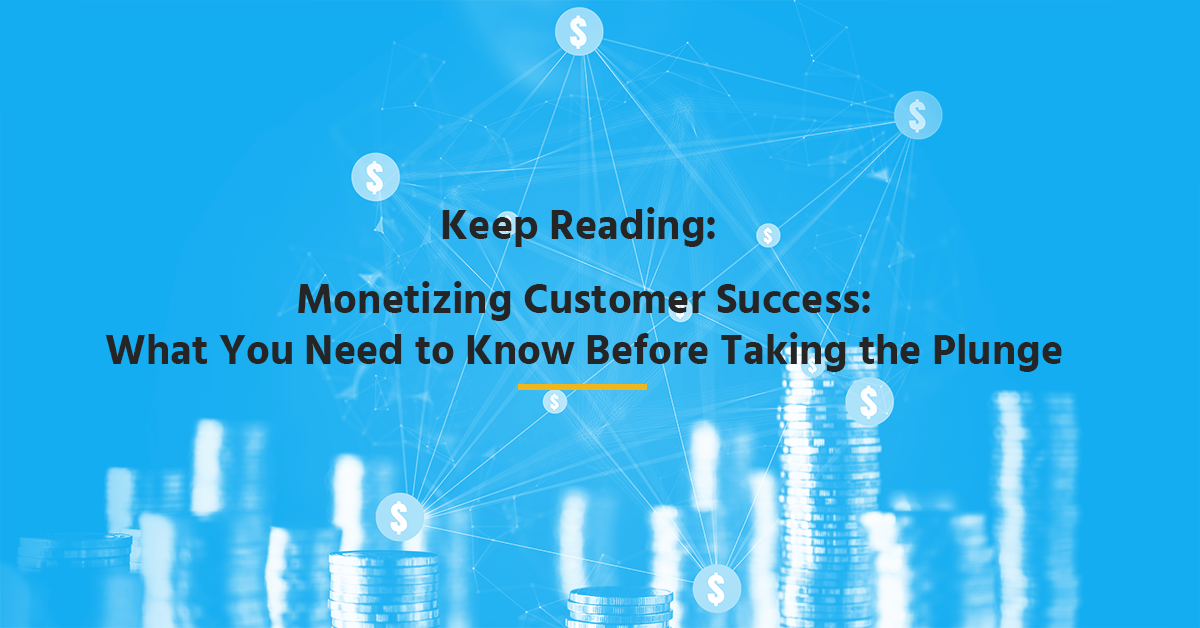Hot! Hot! Hot! These days, the hottest topic in Customer Success is the big “M” word – Monetization. But how do you go about monetizing Customer Success? Many companies are taking a learn as they go approach, testing the waters of charging customers for CS resources a little bit here, a little bit over there. A few standouts are diving into monetization headfirst, reorganizing their entire post-sales ecosystem around fee-based CS services. TSIA believes that if you aren’t monetizing, you’re missing out. At ESG, we take a broad view outlook to monetization. Our Customer Success Maturity Model puts “CS Monetization and Funding” in the final stages of a Customer Success transformation. We believe that to have a successful paid CS program, you first need a solid foundation of proactive Customer Success in place.
If you have that foundation and you’re ready to take the plunge into CS monetization, wonderful! We’ve gathered a ton of tips from organizations who’ve successfully pulled off this transformation. Here are our top Do’s and Don’ts to consider as you reconstruct your CS solution into a revenue-generating machine.
Do align with your company’s overarching goals. Now, every Customer Success organization should make friends with revenue, whether or not your services have been directly monetized. Tying CS to your company’s strategic growth is the best way to ensure that leadership understands and embraces the company-wide strategic value of CS. Without this executive buy-in, you risk watering down the potency of your CS program. Don’t assume monetization means your CS goals will automatically integrate with company growth targets. You need to connect those dots and keep them in mind as you build out your paid program.
Don’t forget to track your critical KPIs and benchmarks. It can be easy to miss this step when you’re busy revamping the structure of an entire organization. To dig deep and get a full picture of performance, you might need to create new KPIs to track, like customer survey data or health score formulas and calculations. If you identify these benchmarks early on, you’ll have a continuous data trail right from the start of your initiative – an invaluable tool as you move through the trial and error stages of a fledgling program.
Do follow through on the promises of your paid CS offers. Once your customers are forking out a fee for Customer Success, you better believe they’re paying a lot more attention to everything they are getting out of that solution. Your CSMs must be able to deliver tangible business value to your customers. If your CS organization didn’t have clearly defined borders before, it needs them now. Providing that value becomes much more straightforward when you have clearly defined boundaries for each tier of your CS services. This also gets easier if you don’t confuse your CSMs and customers with inconsistent product coverage, where a service is available for some product lines but not others. Build out your offering with all of these things in mind, and it will be much easier to follow through on those promised results.
Don’t keep your customers out of the loop. How do you make sure your customers see the value your CSMs are providing them? By telling them, of course! This is especially critical at higher payment tiers. Your CSMs could have a series of check-ins with customers at these levels, where they’re prepared to share deliverables data and performance reports with your customer. Let them see what you’re tracking (at least the data points that pertain to their needs). At lower CS tiers, you can automate these check-ins, sending your customers emails with results-driven data. Bonus points if you note poor satisfaction scores and proactively reach out to solve these issues. This kind of transparency will build your customers’ confidence in your company and your CS team, so they stick with you for the long run.
Do be flexible and keep evolving. Never stop growing. What works best for your customers and your business today won’t necessarily be the best solution tomorrow. The beauty of Customer Success is that it enables your business to continuously evolve and iterate with your customers’ needs. When monetizing Customer Success, it may seem more challenging to adapt to these changes, but it’s more important than ever before. To stay ahead of the competition, customers must experience the value of your solution (see a theme here?). You don’t want them to outgrow it. Plus, rolling with the punches is vital to the long-term success of any program. Versatility will help secure the future of your CS organization through monetization and beyond.
Don’t assume monetization will fix all your problems. Like we said before, we believe successful monetization is built upon a sturdy framework of proactive Customer Success. Many companies are eager to jump into proving ROI by charging customers right out of the gate. While this isn’t impossible, it’s generally not the most advisable route to revenue. Best practices gleaned from top CS leaders say scaling a CS organization can take up to three or more years. If you are hitting a wall, adding the complex task of monetizing Customer Success to the equation isn’t going to fix your problems. In fact, it could make things worse. Genuinely proactive, predictive Customer Success takes time and patience as does building a monetization strategy that positively impacts your business and your customers.
Above all, as you advance toward the right CS monetization strategy for your business, don’t forget about all the advantages you gain with a comprehensive CS organization. This includes building both paid and unpaid options into your new offers. We could talk about the benefits of Customer Success all day long. Don’t lose out by limiting your CS capabilities to paying customers.
Want to find out where you fall on the Customer Success Maturity Model with a CS Maturity Assessment or have questions about monetization? ESG’s team of Customer Success experts is ready to answer your questions.


